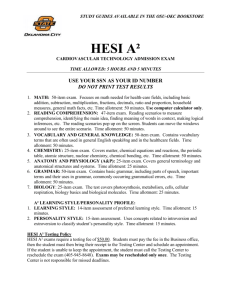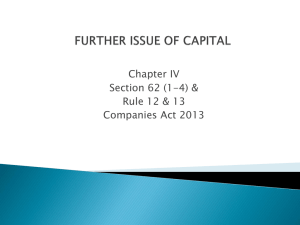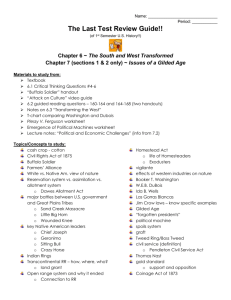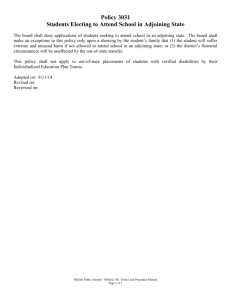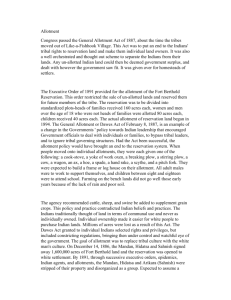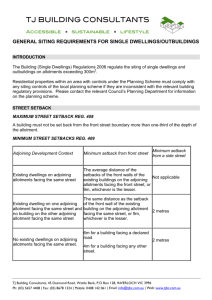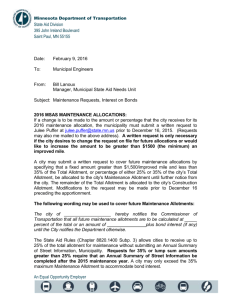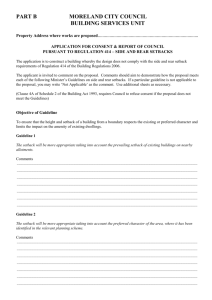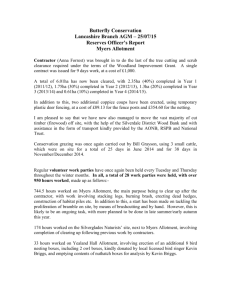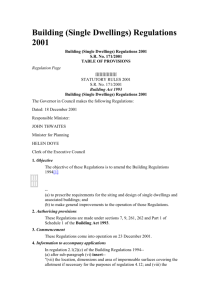General siting requirements
advertisement
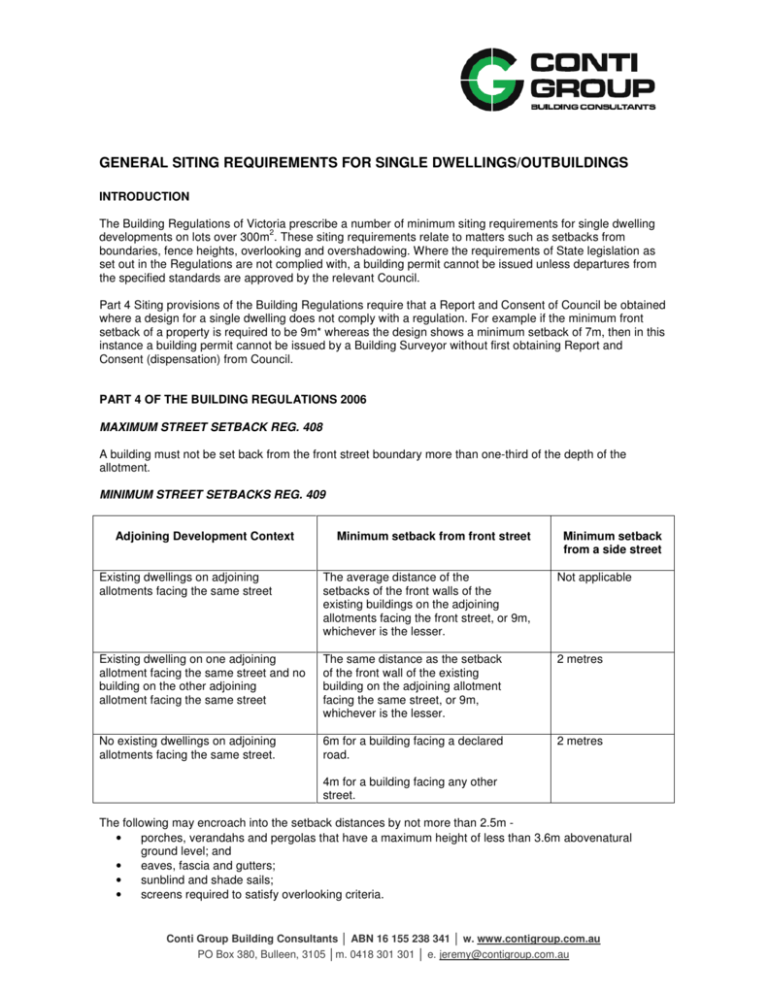
GENERAL SITING REQUIREMENTS FOR SINGLE DWELLINGS/OUTBUILDINGS INTRODUCTION The Building Regulations of Victoria prescribe a number of minimum siting requirements for single dwelling 2 developments on lots over 300m . These siting requirements relate to matters such as setbacks from boundaries, fence heights, overlooking and overshadowing. Where the requirements of State legislation as set out in the Regulations are not complied with, a building permit cannot be issued unless departures from the specified standards are approved by the relevant Council. Part 4 Siting provisions of the Building Regulations require that a Report and Consent of Council be obtained where a design for a single dwelling does not comply with a regulation. For example if the minimum front setback of a property is required to be 9m* whereas the design shows a minimum setback of 7m, then in this instance a building permit cannot be issued by a Building Surveyor without first obtaining Report and Consent (dispensation) from Council. PART 4 OF THE BUILDING REGULATIONS 2006 MAXIMUM STREET SETBACK REG. 408 A building must not be set back from the front street boundary more than one-third of the depth of the allotment. MINIMUM STREET SETBACKS REG. 409 Adjoining Development Context Minimum setback from front street Minimum setback from a side street Existing dwellings on adjoining allotments facing the same street The average distance of the setbacks of the front walls of the existing buildings on the adjoining allotments facing the front street, or 9m, whichever is the lesser. Not applicable Existing dwelling on one adjoining allotment facing the same street and no building on the other adjoining allotment facing the same street The same distance as the setback of the front wall of the existing building on the adjoining allotment facing the same street, or 9m, whichever is the lesser. 2 metres No existing dwellings on adjoining allotments facing the same street. 6m for a building facing a declared road. 2 metres 4m for a building facing any other street. The following may encroach into the setback distances by not more than 2.5m • porches, verandahs and pergolas that have a maximum height of less than 3.6m abovenatural ground level; and • eaves, fascia and gutters; • sunblind and shade sails; • screens required to satisfy overlooking criteria. Conti Group Building Consultants │ ABN 16 155 238 341 │ w. www.contigroup.com.au PO Box 380, Bulleen, 3105 │m. 0418 301 301 │ e. jeremy@contigroup.com.au "Declared road" means a declared road within the meaning of the Transport Act 1983. BUILDING HEIGHT REG. 410 The height of a building must not exceed • 10m if the slope of the natural ground level at any cross section wider than 8m of the site ofthe building is 2.5° or more; or • 9m in any other case. SITE COVERAGE REG. 411 Buildings must not occupy more than 60% of an allotment. Unroofed swimming pools, unroofed terraces and eaves may be disregarded for the purposes of calculating site coverage. PERMEABILITY REG. 412 If a building is to be constructed on an allotment, not more than 80% of the area of the allotment can be covered by impermeable surfaces. CARPARKING REG.413 If a new Class 1 building is to be constructed on an allotment, provision must be made for 2 carparking spaces on the allotment. Of the 2 car parking spaces • one space must be at least 6m long and 3.5m wide; and • the second space must be at least 4.9m long and 2.6m wide. • if the 2 required car parking spaces adjoin each other in a garage or carport or in a spaceconstrained by walls, the double space may be 5.5m in width. An alteration to a building on an allotment must not reduce the number of car parking spaces onthe allotment unless there are more than 2 in which case the number may be reduced to 2. A building may project into a car parking space if it is at least 2.1m above that space. SIDE AND REAR SETBACKS REG. 414 Building height at any point Minimum setback from side or rear boundary at that point 3.6m or less 1m More than 3.6m but not more than 6.9m. 1m plus an additional distance calculated at the rate of 300mm for every metre of height over 3.6m. More than 6.9m. 2m plus an additional distance calculated at the rate of 1m for every metre of height over 6.9m. The following may encroach into the setback distance by not more than 500mm • porches and verandahs; • masonry chimneys; • sun blinds; • screens referred to in Regulation 4.19(4) or 4.19(5); Conti Group Building Consultants │ ABN 16 155 238 341 │ w. www.contigroup.com.au PO Box 380, Bulleen, 3105 │m. 0418 301 301 │ e. jeremy@contigroup.com.au • • • flues and pipes; domestic fuel tanks and water tanks; heating and cooling equipment and other services. The following may encroach into the setback distance • eaves, fascia and gutters 600mm in total width; 2 • landings with an area of not more than 2m and less than 1m high; • unroofed stairways and ramps; • pergolas; • shade sails; • carports (subject to regulation 4.15). WALLS ADJACENT TO BOUNDARIES REG. 415 This applies to the construction of • a wall on or within 150mm of a side or rear boundary of an allotment; • a carport constructed on or within 1m of a side or rear boundary of an allotment. The length of the wall, or of the carport, or of the wall and carport, must not, either by itself or when combined with the length of any existing wall or carport, be greater than the greater of • 10m plus 25% of the remaining length of the boundary of the allotment; or • the length of any existing wall or carport constructed on an adjoining allotment which iswithin 150mm of the boundary of that allotment. If the proposed construction abuts theexisting wall or carport. A wall or carport constructed within 150mm of a side or rear boundary of an allotment must not exceed an average height of 3m and a maximum height of 3.6m along the boundary. If a wall or carport abuts an existing wall it may be constructed to the same height as that wall. DAYLIGHT TO EXISTING HABITABLE ROOM WINDOWS REG. 416 Conti Group Building Consultants │ ABN 16 155 238 341 │ w. www.contigroup.com.au PO Box 380, Bulleen, 3105 │m. 0418 301 301 │ e. jeremy@contigroup.com.au A building must be set back from a habitable room window in an existing building on an adjoining allotment to provide for a light court to the window that has a minimum area of 3m2 and a minimum dimension of 1m clear to the sky. The area of the required light court may include land on the adjoining allotment. A wall or carport with an average height of more than 3m opposite a habitable room window in an existing dwelling on an adjoining allotment must be set back from that window at least half the height of the wall or carport if the wall or carport is within a 55° angle in the horizontal plane about a vertical axis through the centre of the window. The angle may be swung to not less than 35° from the plane of the wall containing the window. If the window is above ground floor level, then for the purposes of that sub-regulation, the wall or carport height is to be measured from the floor level of the room containing the window. SOLAR ACCESS TO EXISTING NORTH FACING HABITABLE ROOM WINDOWS REG. 417 This applies if • a north-facing habitable room window of an existing dwelling on an adjoining allotment iswithin 3m of a boundary of the allotment on which the building is to be constructed; and • the window is orientated towards the boundary. The proposed building must be set back from the boundary not less than the distance specified inthe following Table for a distance of 3m from the edge of each side of the window: Conti Group Building Consultants │ ABN 16 155 238 341 │ w. www.contigroup.com.au PO Box 380, Bulleen, 3105 │m. 0418 301 301 │ e. jeremy@contigroup.com.au Building height at any Point Minimum setback from side or rear boundary at that point 3.6m or less 1m More than 3.6m but not more than 6.9m. 1m plus an additional distance calculated at the rate of 600mm for every metre of height over 3.6m. More than 6.9m. 3m plus an additional distance calculated at the rate of 1m for every metre of height over 6.9m. A north-facing window is a window with an axis perpendicular to its surface oriented north 20° westto north 30° east. OVERSHADOWING REG. 418 A building constructed on an allotment must not reduce the sunlight to a recreational private open space of an existing dwelling on an adjoining allotment to the extent that less than the required minimum area of the recreational private open space has less than 5 hours of sunlight between 9am and 3pm on 22 September. The amount of sunlight to that area must not be further reduced by the construction of any building if the recreational private open space is less than the required amount. In this regulation the required minimum area of a secluded private open space is the lesser of • 75% of the secluded private space; and 2 • 40m with a minimum dimension of 3m. OVERLOOKING REG. 419 A habitable room window or raised open space of a building on an allotment must not provide a direct line of sight into a habitable room window or on to seclude private open space of an existing dwelling on an adjoining allotment within a horizontal distance of 9m (measured at ground level) of the window or raised open space. The direct line of sight must be measured within a 45° angle from the plane of the window or perimeter of the raised open space and from a height of 1.7m above the floor level of the habitable room or raised open space. A habitable room window complies if • it is offset a minimum of 1.5m from the edge of one window to the edge of the other; or • it has a sill height at least 1.7m above floor level; or • it has obscure glazing in any part of the window below 1.7m above floor level; or • it is obscured by a permanent and fixed screen which has no more than 25% of its areaopen. A raised open space complies if the direct line of sight into the habitable room window or secluded private open space on the adjoining allotment is obscured by a permanent and fixed screen which has no more than 25% of its area open. A window may be openable provided that when open the obscure glazing does not permit a direct line of sight into the secluded private open space or habitable room window. This does not apply to a new habitable room window that faces a property boundary if • there is a visual barrier at least 1.8m high at the boundary; and • the floor level of the room is less than 800mm above ground level at the boundary. Raised open space means Conti Group Building Consultants │ ABN 16 155 238 341 │ w. www.contigroup.com.au PO Box 380, Bulleen, 3105 │m. 0418 301 301 │ e. jeremy@contigroup.com.au • • a landing with an area of more than 2m2 and with a floor height of 800mm or more abovenatural ground level at the boundary; or a balcony, terrace, deck or patio with a floor height of 800mm or more above natural ground level at the boundary. Conti Group Building Consultants │ ABN 16 155 238 341 │ w. www.contigroup.com.au PO Box 380, Bulleen, 3105 │m. 0418 301 301 │ e. jeremy@contigroup.com.au DAYLIGHT TO NEW HABITABLE ROOM WINDOWS REG. 420 A habitable room window of a building on an allotment must face • an outdoor space clear to the sky, not including land on an adjoining allotment; or 2 • a lightcourt with a minimum area of 3m and minimum dimension of 1m clear to the sky, not including land on an adjoining allotment; or (c) a verandah on the allotment if it is open for at least one third of its perimeter; or • a carport on the allotment if -it has 2 or more sides open; and -it is open for at least one third of its perimeter. Conti Group Building Consultants │ ABN 16 155 238 341 │ w. www.contigroup.com.au PO Box 380, Bulleen, 3105 │m. 0418 301 301 │ e. jeremy@contigroup.com.au A side of a carport or verandah may be taken to be open if the roof covering of the carport or verandah adjacent to that side is not less than 500mm from another building on the allotment or the adjoining allotment boundary. PRIVATE OPEN SPACE REG. 421 A Class 1 building on an allotment must have private open space of not less than 80m2 or 20% of the area of the allotment, whichever is the lesser. The private open space must include, an area at the side or rear of the building with 2 • an area of at least 25m with a minimum dimension of 3m; and • convenient access from a habitable room (other than a bedroom). DEFINITIONS Private Open Space An unroofed area of land; or A Class 10b building associated with a Class 1 building. Recreational Private Open Space Any part of private open space which is primarily intended for outdoor recreational activities and is enclosed for 90% of it’s perimeter by walls, fences or other barriers at least 1.5m high above finished ground level. Clear to the sky An unroofed area or an area roofed with a material that transmits at least 90% of light. Height The vertical distance between the natural ground level at the base of the building / wall to the top of the roof covering (building) or to the underside of the roof covering at the point at which the outer wall intersects the plane of the roof covering (wall). How to Apply for a Report and Consent (dispensation) An application for report and consent with respect to the Building Regulations siting requirements must be accompaniedwith the following: 1. 2. 3. 4. 5. Filled out council application form providing details pertaining to the application and the Regulation for which the report and consent is being applied for. Details which clearly demonstrate in quantitative and qualitative terms compliance with the Objectives of the Building Regulations and Ministers Decision Guidelines. Conti Group can prepare a submission to the council on behalf of the owner/s providing supportive reasons as to why consent should be given. (fees apply) Copy of title with plan of subdivision and three (3) sets of plans of the subject allotment, adjoining properties and where relevant the location of habitable room windows, private open space, secluded private open space relevant elevations and sections appropriately dimensioned to be provided. Owners of adjoining properties may suffer detriment as a result of the proposal, and therefore council requests adjoining owners comments. If adjoining owners comments are not provided as part of the application, the council may write to all adjoining property owners that are affected which in turn will delay the application. A non-refundable council fee of $227.25is required per clause being varied (e.g. if two clauses are being varied then a council fee of $454.50 will be required). Lack of information in relation to an application is likely to result in processing delays or even refusal. Conti Group Building Consultants │ ABN 16 155 238 341 │ w. www.contigroup.com.au PO Box 380, Bulleen, 3105 │m. 0418 301 301 │ e. jeremy@contigroup.com.au NOTES: 1. This information is provided as a summary of Part 4 of the Building Regulations 2006. We accept no liability for the accuracy or otherwise of this information. 2. No responsibility or liability to any third party is accepted for any loss or damage arising out of the use of this summary. Any third party wishing to use any material contained in this report should first contact Conti Group for detailed advice, which will take into account that party’s particular requirements. 3. It is recommended that specific information be obtained immediately prior to the design process with respect to any building proposal to confirm compliance with the Building Regulations. Should you require any specific advice on any sitting matters please contact Conti Group Building Consultants. Conti Group Building Consultants │ ABN 16 155 238 341 │ w. www.contigroup.com.au PO Box 380, Bulleen, 3105 │m. 0418 301 301 │ e. jeremy@contigroup.com.au
